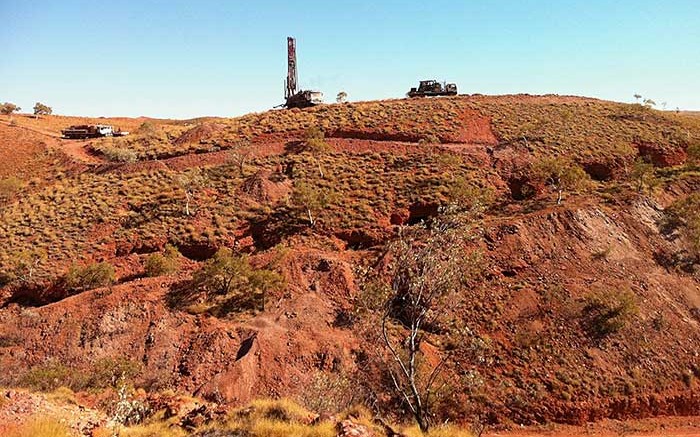VANCOUVER — It’s easy pickings for Novo Resources (US-OTC: NSRPF) at its Beatons Creek paleoplacer gold deposit near the historic gold mining town of Nullagine in the eastern Pilbara region of Western Australia.
The company has expanded the mineralization on its property since releasing its maiden resource in 2013, and new metallurgical tests show the gold is perfect for simple, low-cost gravity separation — an excellent combination for a company keen on developing a modest, low-cost and profitable operation in one of Australia’s well-known mining districts.
The Northern Miner spoke with Quinton Hennigh, president and CEO of Novo Resources, by phone to find out what’s next for the Vancouver-based junior.
“We are focused like a laser on getting the new oxide resource put together and brought up to feasibility by late this year or early next,” he said. “What we envision is a 30,000 oz. per year operation for over eight years.”
Novo identified a 8.9-million-tonne resource of 1.5 grams gold per tonne for 421,000 contained oz. gold (using a 0.5 gram gold cut-off) in 2013, catching the eye of gold giant Newmont Mining (NYSE: NEM), which has since retained a 28% stake in the junior.
The resource is partly exposed at surface and hosted within an Archean-aged conglomeratic unit that dips gently under cover towards the northwest.
The highest grades are within several stacked “reefs” up to a kilometre in length, along an ancient basin escarpment. Novo believes this “fossil” gold was mechanically transported through braided rivers and alluvial fans, but also carried in aqueous solution similar to a Witwatersrand-style setting.
“There’s certainly placer gold that has been washed into the basin, but we also see a lot of finer-grained gold that looks almost crystalline. It’s bit of a mystery,” Hennigh said, while mentioning the project’s similarities in age and stratigraphy with the 1.6 billion oz. Witwatersrand gold deposit in South Africa.
Novo’s exploration strategy shifted last year towards investigating its shallow resource when metallurgical tests identified free-milling gold in the majority of the oxidized samples studied.
“In oxide we get a clean gold concentrate using simple gravitational separation, and the conglomerate just crumbles completely apart,” he explained. “It’s a low-cost exercise, which makes a lot of sense for our company.”
The 2013 resource for the property contains 16% oxide material, so Novo has spent the past year targeting all of the prospective horizons within 20 metres of surface.
The new step-out drilling from surface appears to be several orders of magnitude larger than the previous work, but the surface area on the pending resource is greatly reduced by gently rugged topography and drainages.
Intercepts include 6 metres at 8.8 grams gold in hole 14-98 and 4 metres at 2.8 grams gold in hole 14-190.
“That’s the only heartbreaking thing about this project, as you go further north the horizons sky-out,” Hennigh said. “The reefs here are great, so it makes me wonder what it was like 10 million years ago, before a part of it was eroded away.”
Regardless, he expects an easy 250,000 to 400,000 oz. shallow oxide resource to go on the books by year-end, and intends to bring the project to feasibility. Upon doing so, Novo will attain its 70% earn-in requirement with Millennium Minerals.
“We have an opportunity here to put something into production, which will be exceptional for a junior company. The shallow-oxide resource is a reasonable, low cost exercise, which is something we can tackle, develop and profit from.”
In other exploration, Novo drilled a deep stratigraphic hole, 4 km southwest of the current resource to test the lateral and vertical extent of the system. The hole intercepted four reefs at 500 metres deep, with 0.38 to 0.5 gram gold per tonne over lengths ranging from 0.5 to 1.5 metres. Hennigh always suspected that the intercepts represent the erosional scarp’s distal parts.
“It’s not very far before you go from big conglomerates to finer sediments, so there must’ve been a pretty sharp gradient relief on the basin as it was forming,” he said. “But it’s just one hole, so even if it’s just a few sniffs, it’s still highly encouraging.”
The gold is interpreted to have eroded from mesothermal, lode-gold deposits that are commonly found in the older parts of the regional stratigraphy. The nearest deposit to Beatons Creek is Millennium Minerals’ Nullagine gold project, with total resources of 1.2 million oz. gold.
About 70 km northwest of Beatons Creek at its Marble Bar property, Novo will also get exploration underway for gold-bearing conglomerates. Hennigh says the prospect looks intriguing, with a 600-metre reef identified last year at surface showing grades of up to 6 grams gold.


Be the first to comment on "Golden payoff in the Pilbara for Novo Resources"